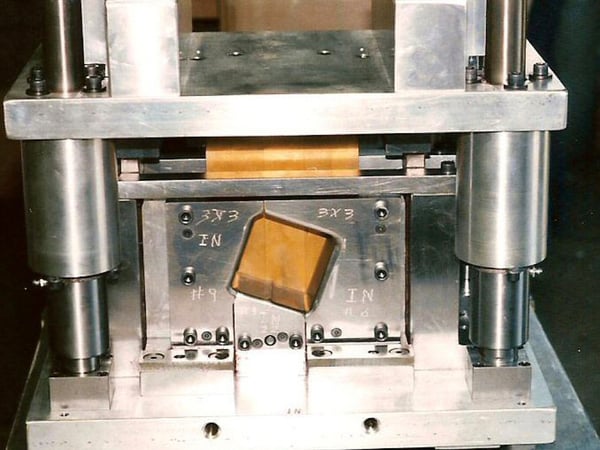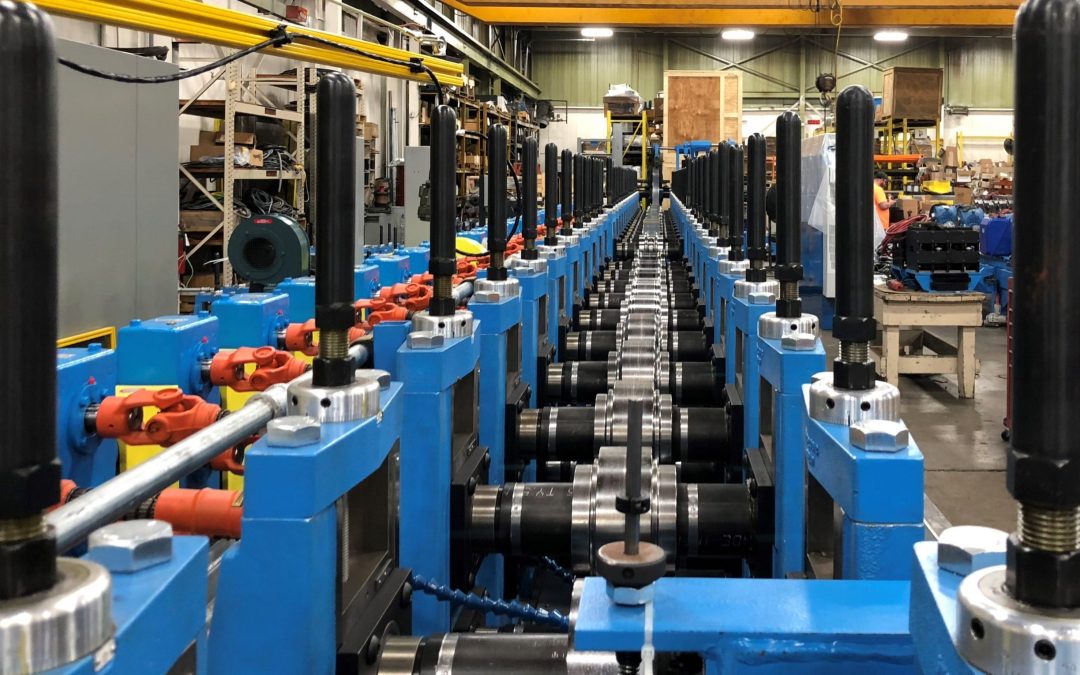In metal fabrication and manufacturing, choosing the correct cutoff system directly correlates to the profitability of the roll forming line. As a critical component of roll forming operations, the cutoff die impacts the speed and efficiency of each line, which ultimately determine the profitability of a line. In this post, we'll discuss the different cutoff press design options and how each affects the economic performance of the line.
Profitability Considerations for Roll Forming Cutoff Dies
Stroke and Die Travel
Assuming that a given shape can be cut off using either a blade cut or a crop cut (slugless), there are many definite economic advantages to using a slugless die.
If a blade cut die is used on a simple 1/8-inch thick “CEE” channel that is 3 inches wide and has legs that are both 2 inches high, it takes at least 2-1/4 inches of stroke to sever the part and push the slug down. Assuming the press is a 275 RPM press with a 3-inch stroke, and the line is traveling at 100 FPM, the die would travel 3-1/4 inches out during each cutoff stroke.
If a crop die is used instead, only the bottom 1/4 inch of the stroke is needed, and 3/8 inches of die travel is used. The blade cut die can keep line speed down if there is not much bolster length for die travel, if a positive stop is used (which adds to the die travel), or if the press has a slower RPM. In short-bed medium RPM presses, the line speed could be almost doubled just by using a slugless cutoff (in some cases).
Slugs and Material Savings
With the expense of steel today and heavier gauge parts being run, the 3/16 to 3/8-inch thick slug, which is taken out each time a cut is made, quickly adds up to a potential cost saver. When taking out a slug, not only the obvious direct cost of the material is involved but also the cost of handling the constant flow of slugs from the press to the scrap collector.
There is also the problem of slug pulling, which can over-travel the die, jam the line, and therefore cause downtime. To alleviate the problem, one option is to lower the shut height in order to push the slug lower. This has the effect of increasing die travel, which in some situations, could cause the line to slow down.
Die Maintenance and Labor Savings
Die maintenance is a big factor in the economic considerations of a roll forming line. If there is no backup tooling, any time the dies are out for sharpening in the middle of a run, the entire line is down.
There is a tremendous difference between a blade cut and a crop cut die in total die life and length of run between sharpenings. The pressure buildup and resultant blade face gaulling from the blade traveling down the leg of a piece part is much greater than in a crop die where the blade is only traveling across the thickness of the part and not down the part. If the blade deteriorates so does the quality of the cut.
In some lines, the blade must be changed or sharpened every few hours. In cases like these, it is much cheaper if replacement blades are kept on-hand so downtime is kept to a minimum. Not only does this continued maintenance affect line downtime directly, but it also affects overhead costs. An extra maintenance worker could possibly be eliminated when eliminating the extra maintenance required because of running blade cut dies.
Combination Dies and Secondary Operations
The savings involved, directly and indirectly, in running combination dies can be manifold. If the die can punch and/or form while it is cutting off, the time savings can determine if the product is very profitable or just marginal. Sometimes the line must be slowed down to accommodate these extra operations, and the resultant speed must be weighed against the savings from the elimination of secondary operations.
Performing more operations in the cutoff than in a prenotch die offers significant advantages.
- There is always some growth between holes in the roll forming process. If all holes are punched in the cutoff, there is no worry about growth.
- The line can usually be run faster with no prenotching operations, even when performing additional operations in the cutoff.
- Since the cutoff press is already in the line, as long as the tonnage is enough, extra operations are "free," in a sense.
- This also releases the use of the prenotch press for other lines.
Increasing Profitability with Prenotch Dies
Without being able to automatically gag punches in or out on any stroke of the press, the prenotching, setup for some lines would have to be changed. In many cases, auto gagging punches could not be done at all except in secondary operations with much more expense, much lower line speeds, and possibly additional presses required.
In a roll forming line, the dies are tightly confined. Pulling a die out in order to change punching configurations can be very time consuming, especially when large dies are involved. To minimize this changeover time, which can sometimes take hours, manual gags and/or ball-lock punches should be used whenever possible.
If changeover time is converted into potential production, the direct loss can be substantial in some cases. This can also mean tying up a line which could be running other items.
By choosing the correct cutoff dies and roll forming line setup, fabricators have the power to boost efficiency and profitability in the shop. To maximize the economic returns of an investment in cutoff methods and equipment, it's critical to consider the advantages of slugs vs. slugless dies, die maintenance requirements, and the benefits of combination as well as prenotch dies in roll forming. Equipment providers can be instrumental in helping choose the correct cutoff tooling for any manufacturer's needs.



